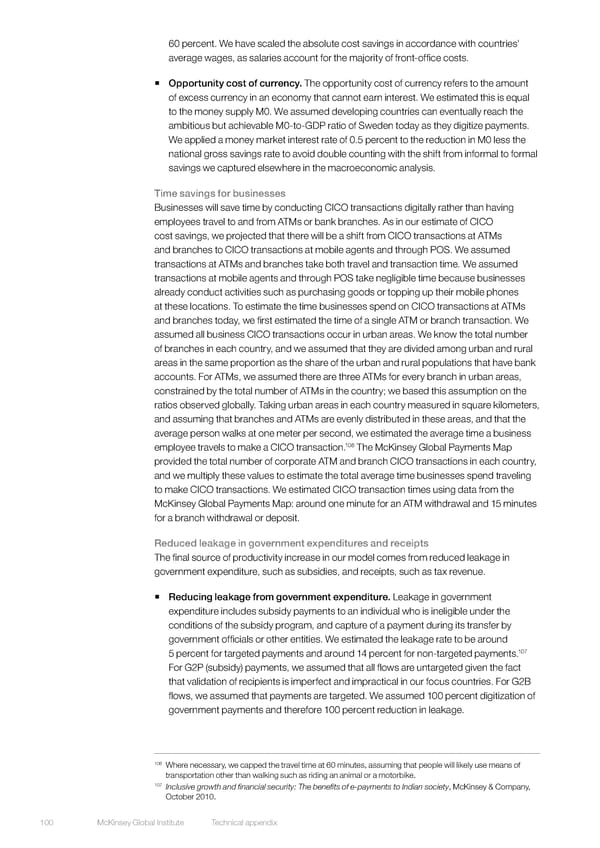60 percent. We have scaled the absolute cost savings in accordance with countries’ average wages, as salaries account for the majority of front-office costs. ƒ Opportunity cost of currency. The opportunity cost of currency refers to the amount of excess currency in an economy that cannot earn interest. We estimated this is equal to the money supply M0. We assumed developing countries can eventually reach the ambitious but achievable M0-to-GDP ratio of Sweden today as they digitize payments. We applied a money market interest rate of 0.5 percent to the reduction in M0 less the national gross savings rate to avoid double counting with the shift from informal to formal savings we captured elsewhere in the macroeconomic analysis. Time savings for businesses Businesses will save time by conducting CICO transactions digitally rather than having employees travel to and from ATMs or bank branches. As in our estimate of CICO cost savings, we projected that there will be a shift from CICO transactions at ATMs and branches to CICO transactions at mobile agents and through POS. We assumed transactions at ATMs and branches take both travel and transaction time. We assumed transactions at mobile agents and through POS take negligible time because businesses already conduct activities such as purchasing goods or topping up their mobile phones at these locations. To estimate the time businesses spend on CICO transactions at ATMs and branches today, we first estimated the time of a single ATM or branch transaction. We assumed all business CICO transactions occur in urban areas. We know the total number of branches in each country, and we assumed that they are divided among urban and rural areas in the same proportion as the share of the urban and rural populations that have bank accounts. For ATMs, we assumed there are three ATMs for every branch in urban areas, constrained by the total number of ATMs in the country; we based this assumption on the ratios observed globally. Taking urban areas in each country measured in square kilometers, and assuming that branches and ATMs are evenly distributed in these areas, and that the average person walks at one meter per second, we estimated the average time a business 106 The McKinsey Global Payments Map employee travels to make a CICO transaction. provided the total number of corporate ATM and branch CICO transactions in each country, and we multiply these values to estimate the total average time businesses spend traveling to make CICO transactions. We estimated CICO transaction times using data from the McKinsey Global Payments Map: around one minute for an ATM withdrawal and 15 minutes for a branch withdrawal or deposit. Reduced leakage in government expenditures and receipts The final source of productivity increase in our model comes from reduced leakage in government expenditure, such as subsidies, and receipts, such as tax revenue. ƒ Reducing leakage from government expenditure. Leakage in government expenditure includes subsidy payments to an individual who is ineligible under the conditions of the subsidy program, and capture of a payment during its transfer by government officials or other entities. We estimated the leakage rate to be around 107 5 percent for targeted payments and around 14 percent for non-targeted payments. For G2P (subsidy) payments, we assumed that all flows are untargeted given the fact that validation of recipients is imperfect and impractical in our focus countries. For G2B flows, we assumed that payments are targeted. We assumed 100 percent digitization of government payments and therefore 100 percent reduction in leakage. 106 Where necessary, we capped the travel time at 60 minutes, assuming that people will likely use means of transportation other than walking such as riding an animal or a motorbike. 107 Inclusive growth and financial security: The benefits of e-payments to Indian society, McKinsey & Company, October 2010. 100 McKinsey Global Institute Technical appendix
 DIGITAL FINANCE FOR ALL Page 117 Page 119
DIGITAL FINANCE FOR ALL Page 117 Page 119